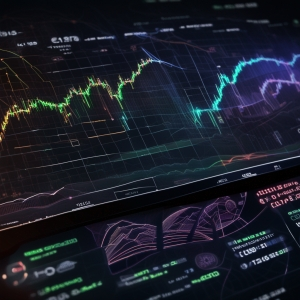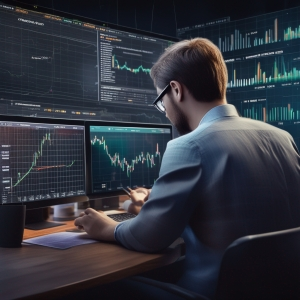Table of Contents:
Introduction to Technical Analysis
If you have just stepped into the world of crypto investments, you might have come across the term Crypto Technical Analysis. This is a popular method many investors use to predict crypto market trends and make informed investment decisions. In a highly volatile industry such as digital currencies, being able to forecast the market direction can be critical for your investment success.
Crypto Technical Analysis is an analytic approach that involves examining price charts and other market activities. These analyses are conducted to predict future price movements of a particular cryptocurrency. While it may sound complex, understanding the basics of Crypto Technical Analysis is quite attainable, even for beginners in the cryptocurrency market.
As we dive deep into this topic, remember that while this technique has proved helpful for many, it's never a guarantee for success. The crypto market, like any other market, can be influenced by many unpredictable factors. Yet, being able to read the signs can give you a leg-up in making more educated guesses about future price actions.
In this article, we will explore the ins and outs of Crypto Technical Analysis. By the end of it, you will be better equipped to predict the next big move in the crypto market.
So, let’s delve in!
Understanding the Fundamentals
At its core, Crypto Technical Analysis is about identifying patterns within chaotic market data. It operates on two key assumptions: First, that the market prices already reflect all the relevant information, and second, that price movements are not completely random but tend to follow certain patterns and trends.
These patterns and trends are usually identified using various charting tools and methods. There's a range of chart types commonly used, such as line charts, bar charts, and the popular candlestick charts. Regardless of the type, charts visualize price movements over a given period and can offer a valuable look at market behavior.
Another crucial part of Crypto Technical Analysis is understanding and applying technical indicators. These are statistical calculations based on elements like price, volume, and open interest. Examples of common indicators include Relative Strength Index (RSI), Moving Average Convergence Divergence(MACD), and Bollinger Bands. Each can offer different insights into possible market turnarounds or confirmations of the current trend.
Lastly, there's market psychology to consider. This aspect examines the collective sentiment of the market participants and can be an influential factor in predicting price movements.
By understanding these fundamentals, you’re off to a good start in your Crypto Technical Analysis journey.
Pro-Contra Analysis on Technical Predictions on Crypto
| Pro-Arguments | Con-Arguments |
|---|---|
| Helps identify potential buying and selling opportunities | May not always accurately predict the market |
| Can be used to understand market trends and volatility | Requires knowledge in statistics and data analysis |
| Offers detailed and deep insights into market trajectories | Could promote risky trading behavior if not handled correctly |
| Supports investors in managing risks and rewards | May not take into consideration external and unpredictable factors |
The Role of Chart Patterns

Chart patterns are a significant component of Crypto Technical Analysis. They are specific formations created by the price movements charted over various time frames and are a critical tool in an analyst's toolbox. Essentially, these patterns indicate the likelihood of a specific_price_movement based on previous market trends and price behaviors.
Chart patterns are broadly divided into two types: continuation patterns and reversal patterns. As the names suggest, continuation patterns indicate that an existing trend is likely to continue, whereas reversal patterns hint at a possible change of the current trend.
Continuation patterns include formations such as pennants, flags, and wedges. Similarly, reversal patterns embody formations like head and shoulders, double tops and bottoms and more. Each pattern comprises various attributes and distinct signals that can give a peek into what might be coming next.
For instance, a well-known pattern is the ‘head and shoulders,’ a reversal pattern. It forms during an uptrend and hints at a potential reversal to a downtrend. The pattern gets its name due to its visual similarity to a head with two shoulders.
By learning to identify these patterns, users can form assumptions about future price movements and make decisions accordingly. However, it's crucial to note that these patterns, while reliable to a degree, can sometimes be misleading. Hence, it's always wise to consider other factors alongside chart patterns when performing Crypto Technical Analysis.
Indicator-based Analysis
In addition to chart patterns, Crypto Technical Analysis heavily relies on a concept known as indicators. These are mathematical calculations based on a currency’s price and volume. They produce data points that can visualize patterns and overlying trends, which traders use to make decisions.
Indicators can generally be categorized into two groups: leading indicators and lagging indicators. While the former can predict future price movements, the latter confirm trends and patterns after they have already occurred.
Indicators like the Moving Average (MA), Moving Average Convergence Divergence (MACD) and the Relative Strength Index (RSI) are widely used in Crypto Technical Analysis.
The Moving Average helps to smooth out price fluctuations over a specific time period and identifies the market direction. On the other hand, MACD, a momentum oscillator, is utilized to signal potential buy or sell opportunities via the crossover of signal lines. RSI, another type of momentum oscillator, measures the speed and magnitude of recent price changes and is especially useful in identifying overbought or oversold conditions.
In summary, the use of indicators should be part of an investor's arsenal in conducting Crypto Technical Analysis. It's important to understand these indicators' strengths and limitations and how to use them effectively to make informed trading decisions.
Popular Crypto Technical Analysis Tools

To efficiently conduct a Crypto Technical Analysis, you need access to tools and platforms that seamlessly allow examination of market trends and indicators. Here, we will take a look at some of the most popular and widely-used Crypto Technical Analysis tools among crypto investors and traders.
TradingView: TradingView is a social platform for traders and investors. It offers a powerful charting tool for conducting a technical analysis of any cryptocurrency. It also provides access to numerous indicators and drawing tools. Sharing and discussing various analysis with a community of knowledgeable traders can be beneficial.
Coinigy: Coinigy is another great platform for crypto market analysis. It integrates with numerous exchanges and allows you to conduct your analysis and execute trades from a single dashboards. Its advanced tools and a large set of indicators make it a favorite among seasoned crypto traders.
CryptoCompare: CryptoCompare offers a comprehensive platform for market data and analysis. Its interactive platform provides historical price data and charting tools for a large number of cryptocurrencies. It also provides trading insights and portfolio tracking functionalities.
Autoview: Autoview is a chrome extension that allows you to automate your trading on various exchanges. It uses TradingView alerts to place trades on your behalf, enabling automated trading based on your technical analysis.
In the world of Crypto Technical Analysis, these tools empower investors to make informed investment decisions. They can give you insights into current market trends, help you identify potential investment opportunities, and manage your trades effectively.
Remember, while these tools are quite powerful, they are just tools. They don't guarantee success. It's still important for you to continuously learn and stay updated about the crypto market movements and news.
Level up Your Trading Strategy
Armed with technical indicators, chart patterns, and an understanding of market psychology, you’re ready to incorporate Crypto Technical Analysis into your trading strategy. As opposed to simply buying or selling based on instinct or hearsay, a data-driven approach can significantly improve your odds of success.
Whether you’re a day trader seeking quick profits or a long-term investor looking for substantial trends, technical analysis tools offer value. By identifying market trends, assessing volumes and volatility, and spotting potential reversals in advance, you can trade more confidently and effectively.
For instance, when an asset is trending upwards, you might decide to hold, anticipating further price appreciation. Conversely, identifying a possible downward trend could signal a good time to sell before the value drops further.
However, it's important to remember the rule of diversification. While Crypto Technical Analysis can help you predict potential market moves, avoiding putting all your eggs in one basket. Spread your investments across different assets and hedge against risk with varied time horizons and trading strategies. This way, even if your predictions aren't always on point, your risk is diluted.
Moreover, never stop learning and adapting. The crypto market is dynamic and ever-changing, and as a trader or investor, so should your strategies be. Stay updated with market news, follow the latest trends, and consistently refine your technical analysis skills. This persistent learning process can help you stay ahead in the game.
Lastly, be patient and disciplined. Successful trading is a marathon, not a sprint. Allow your strategies to play out over time, stay disciplined in your decision-making, and most importantly, do not let emotions dictate your trades. A calm, well-thought-out approach can often lead to more lucrative results.
Making Predictions with Confidence

Now that you're acquainted with the fundamentals of Crypto Technical Analysis, you might wonder, how can one make accurate predictions? While no method guarantees perfect accuracy, certain practices can boost your confidence in making predictions.
Firstly, a comprehensive understanding of the market's historical data can be advantageous. Historical prices and patterns can often shed light on future market behavior. Keeping an eye on broader market trends can afford you a better perspective, especially in volatile markets like crypto.
Secondly, combining various technical analysis methods can enhance the accuracy of your predictions. For instance, applying both chart patterns and indicators can contribute to a more holistic view of market trends. It's important to remember that no single tool or method offers a complete picture. Therefore, a combination of methods, honed through experience and practice, usually leads to better predictions.
Furthermore, staying updated on industry news, technological developments, and regulatory updates can guide your analysis. Such factors are often key triggers of significant market movements.
Lastly, emotional discipline is key in the field of technical analysis. The crypto market is filled with highs and lows, and it's easy to get swayed by momentary trends. Having a disciplined approach, offering room for both profits and losses, may be what sets successful crypto investors apart.
Remember, Crypto Technical Analysis is not an exact science. It's more of a risk management tool—an aid to making more educated guesses rather than certain predictions. With time and practice, you may find yourself increasingly comfortable with making predictions that have the potential to pay off.
Conclusion: The Power of Technical Analysis
In this thrilling and rapidly changing world of cryptocurrencies, Crypto Technical Analysis stands as a powerful tool for both novice and seasoned investors. Understanding the intricacies of historical price movements and market trends can significantly improve your ability to make informed investment decisions.
However, it's worth noting that technical analysis, like any predictive method, comes with its own set of challenges and limitations. It is best used in conjunction with other tools and strategies, such as fundamental analysis, to provide a comprehensive understanding of the market dynamics. Always remember not to rely solely on one method or technique in investment strategies.
On the whole, delving deep into the mechanics of Crypto Technical Analysis reveals its potential as a game-changer for your crypto investment journey. By understanding how to parse complex charts and decipher market indicators, we can translate the information into actionable investment strategies.
So, strengthen your analytical skills, keep expanding your crypto knowledge base, and prepare to ride the waves of the crypto market with confidence.
Frequently Asked Questions about Technical Analysis in Crypto
What is technical analysis in crypto?
Technical analysis in crypto involves evaluating cryptocurrencies through the study of statistical trends, collected from trading activity such as price and volume.
How is technical analysis used to predict the next big crypto move?
Traders use various technical analysis tools like trend lines, support and resistance levels, and indicators like moving averages and Relative Strength Index (RSI) to predict possible price trends and make informed trading decisions.
Is technical analysis 100% accurate in predicting crypto moves?
No, technical analysis isn't 100% accurate. It's a probabilistic tool used to gauge potential price trajectories, not a crystal ball that can predict exact price levels.
What is the best strategy for technical analysis?
There isn't a 'best' strategy that suits all traders, as it depends on individual trading style, risk appetite and time availability. Experimentation, back-testing, and continual learning are crucial.
Can I rely solely on technical analysis for my trading decisions?
While technical analysis can be a powerful predictive tool, it's advisable to augment it with fundamental analysis and stay updated with market news to consider all possible factors influencing price trends.












